2017 KIA CARENS RHD ESP
[x] Cancel search: ESPPage 21 of 723

33
Safety features of your vehicle
WARNING- Loose objects
Loose objects in the driver’s
foot area could interfere with
the operation of the foot pedals,
possibly causing an accident.
Do not place anything under the
front seats.WARNING - Driver
responsibility for front seat
passenger
Riding in a vehicle with a front
seatback reclined could lead to
serious or fatal injury in an acci-
dent. If a front seat is reclined
during an accident, the occu-
pant’s hips may slide under the
lap portion of the seat belt
applying great force to the
unprotected abdomen. Serious or fatal internal injuries
could result. The driver must
advise the front passenger to
keep the seatback in an upright
position whenever the vehicle isin motion.
1KMN3661
WARNING
Do not use a sitting cushion that reduces friction between the
seat and passenger. The passen-
ger's hips may slide under the
lap portion of the seat belt dur-
ing an accident or a sudden
stop. Serious or fatal internalinjuries could result because the
seat belt can't operate normally.
Page 42 of 723
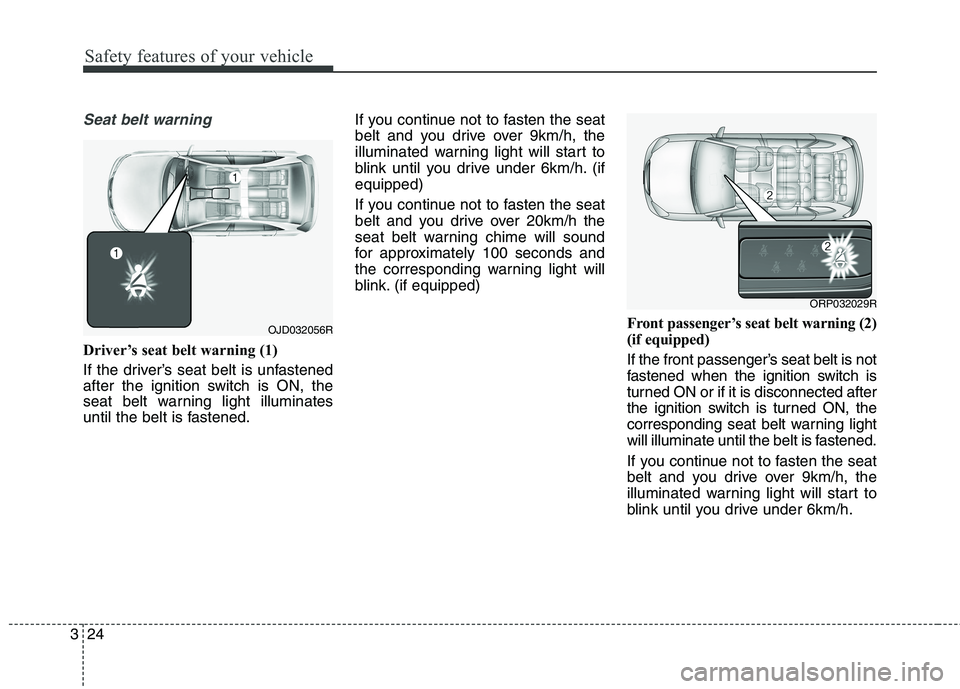
Safety features of your vehicle
24
3
Seat belt warning
Driver’s seat belt warning (1)
If the driver’s seat belt is unfastened
after the ignition switch is ON, the
seat belt warning light illuminates
until the belt is fastened. If you continue not to fasten the seat
belt and you drive over 9km/h, the
illuminated warning light will start to
blink until you drive under 6km/h. (ifequipped)
If you continue not to fasten the seat
belt and you drive over 20km/h the
seat belt warning chime will sound
for approximately 100 seconds and
the corresponding warning light will
blink. (if equipped)
Front passenger’s seat belt warning (2)
(if equipped)
If the front passenger’s seat belt is not
fastened when the ignition switch is
turned ON or if it is disconnected after
the ignition switch is turned ON, the
corresponding seat belt warning light
will illuminate until the belt is fastened.
If you continue not to fasten the seat
belt and you drive over 9km/h, the
illuminated warning light will start to
blink until you drive under 6km/h.
ORP032029R
OJD032056R
Page 43 of 723
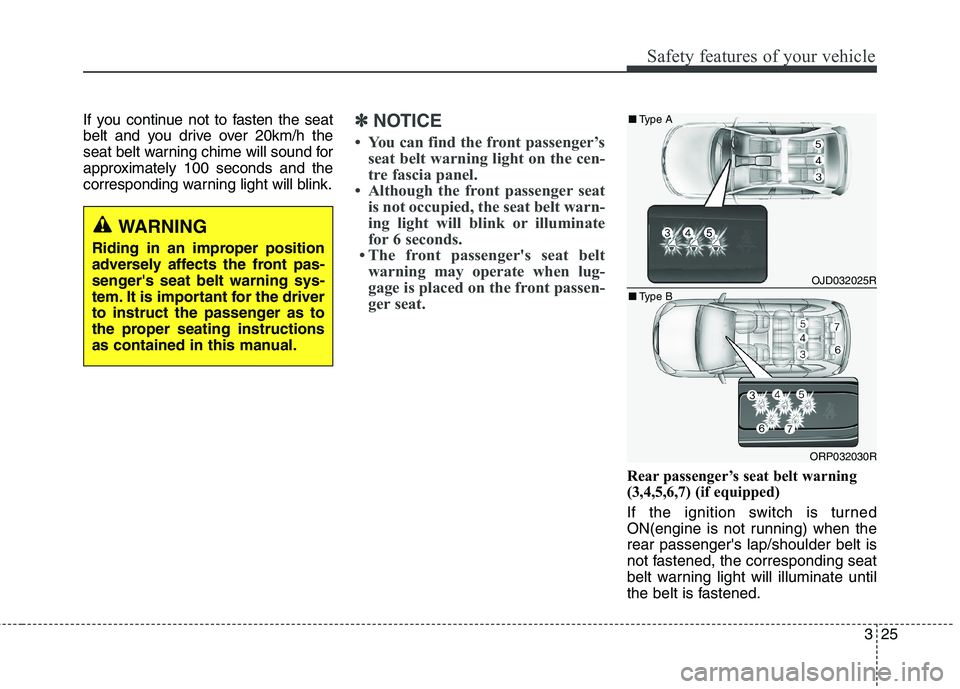
325
Safety features of your vehicle
If you continue not to fasten the seat
belt and you drive over 20km/h the
seat belt warning chime will sound for
approximately 100 seconds and the
corresponding warning light will blink.✽✽NOTICE
You can find the front passenger’s seat belt warning light on the cen-
tre fascia panel.
Although the front passenger seat is not occupied, the seat belt warn-
ing light will blink or illuminate
for 6 seconds.
The front passenger's seat belt warning may operate when lug-
gage is placed on the front passen-
ger seat.
Rear passenger’s seat belt warning
(3,4,5,6,7) (if equipped)
If the ignition switch is turned
ON(engine is not running) when therear passenger's lap/shoulder belt is
not fastened, the corresponding seat
belt warning light will illuminate until
the belt is fastened.
WARNING
Riding in an improper position
adversely affects the front pas-
senger's seat belt warning sys-
tem. It is important for the driver
to instruct the passenger as to
the proper seating instructions
as contained in this manual.
OJD032025R
ORP032030R
■
Type A
■ Type B
Page 44 of 723
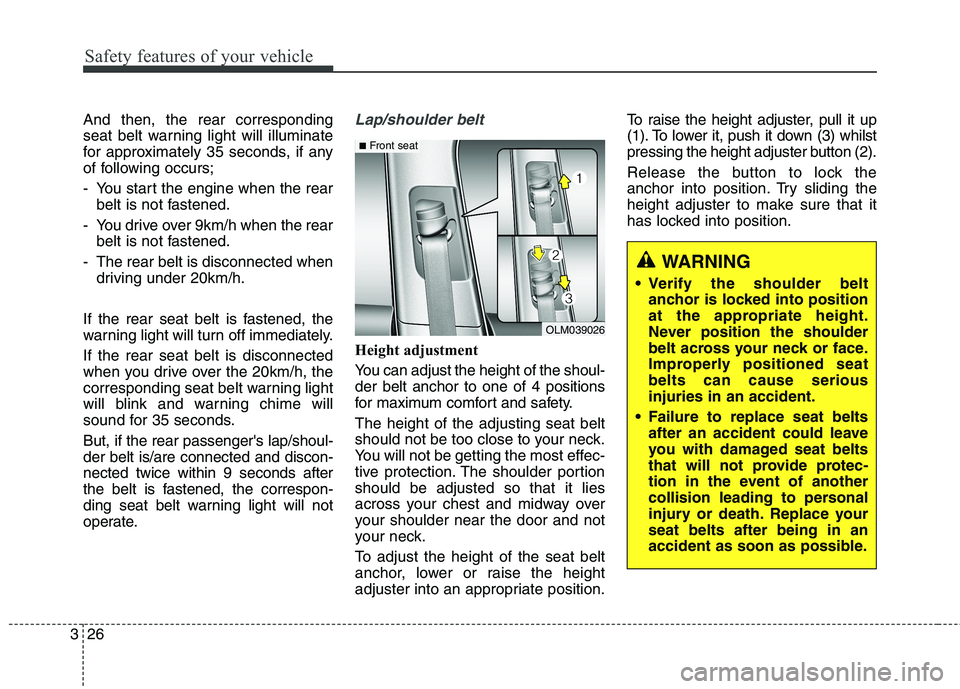
Safety features of your vehicle
26
3
And then, the rear corresponding
seat belt warning light will illuminate
for approximately 35 seconds, if any
of following occurs;
- You start the engine when the rear
belt is not fastened.
- You drive over 9km/h when the rear belt is not fastened.
- The rear belt is disconnected when driving under 20km/h.
If the rear seat belt is fastened, the
warning light will turn off immediately. If the rear seat belt is disconnected
when you drive over the 20km/h, the
corresponding seat belt warning light
will blink and warning chime will
sound for 35 seconds. But, if the rear passenger's lap/shoul- der belt is/are connected and discon-nected twice within 9 seconds after
the belt is fastened, the correspon-
ding seat belt warning light will not
operate.Lap/shoulder belt
Height adjustment
You can adjust the height of the shoul- der belt anchor to one of 4 positions
for maximum comfort and safety. The height of the adjusting seat belt
should not be too close to your neck.
You will not be getting the most effec-
tive protection. The shoulder portionshould be adjusted so that it lies
across your chest and midway over
your shoulder near the door and not
your neck.
To adjust the height of the seat belt
anchor, lower or raise the height
adjuster into an appropriate position. To raise the height adjuster, pull it up
(1). To lower it, push it down (3) whilst
pressing the height adjuster button (2).
Release the button to lock the
anchor into position. Try sliding the
height adjuster to make sure that it
has locked into position.
OLM039026
■
Front seat
WARNING
Verify the shoulder belt anchor is locked into position
at the appropriate height.
Never position the shoulder
belt across your neck or face.
Improperly positioned seatbelts can cause seriousinjuries in an accident.
Failure to replace seat belts after an accident could leave
you with damaged seat belts
that will not provide protec-
tion in the event of another
collision leading to personal
injury or death. Replace yourseat belts after being in an
accident as soon as possible.
Page 58 of 723
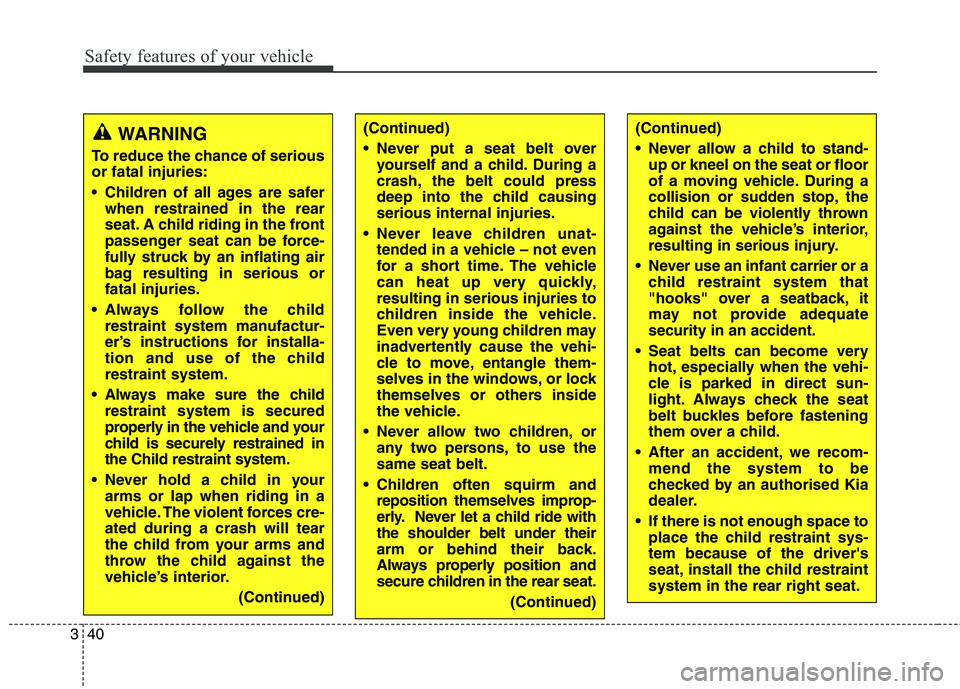
Safety features of your vehicle
40
3
WARNING
To reduce the chance of serious or fatal injuries:
Children of all ages are safer when restrained in the rear
seat. A child riding in the front
passenger seat can be force-
fully struck by an inflating air
bag resulting in serious orfatal injuries.
Always follow the child restraint system manufactur-
er’s instructions for installa-
tion and use of the childrestraint system.
Always make sure the child restraint system is secured
properly in the vehicle and your
child is securely restrained inthe Child restraint system.
Never hold a child in your arms or lap when riding in a
vehicle. The violent forces cre-ated during a crash will tear
the child from your arms and
throw the child against the
vehicle’s interior.
(Continued)(Continued)
Never put a seat belt overyourself and a child. During a
crash, the belt could press
deep into the child causingserious internal injuries.
Never leave children unat- tended in a vehicle – not even
for a short time. The vehicle
can heat up very quickly,resulting in serious injuries to
children inside the vehicle.
Even very young children may
inadvertently cause the vehi-
cle to move, entangle them-
selves in the windows, or lock
themselves or others inside
the vehicle.
Never allow two children, or any two persons, to use thesame seat belt.
Children often squirm and reposition themselves improp-
erly. Never let a child ride withthe shoulder belt under their
arm or behind their back.
Always properly position and
secure children in the rear seat.
(Continued)(Continued)
Never allow a child to stand-up or kneel on the seat or floor
of a moving vehicle. During a
collision or sudden stop, the
child can be violently thrown
against the vehicle’s interior,
resulting in serious injury.
Never use an infant carrier or a child restraint system that
"hooks" over a seatback, it
may not provide adequatesecurity in an accident.
Seat belts can become very hot, especially when the vehi-
cle is parked in direct sun-
light. Always check the seat
belt buckles before fastening
them over a child.
After an accident, we recom- mend the system to be
checked by an authorised Kia
dealer.
If there is not enough space to place the child restraint sys-tem because of the driver's
seat, install the child restraintsystem in the rear right seat.
Page 64 of 723
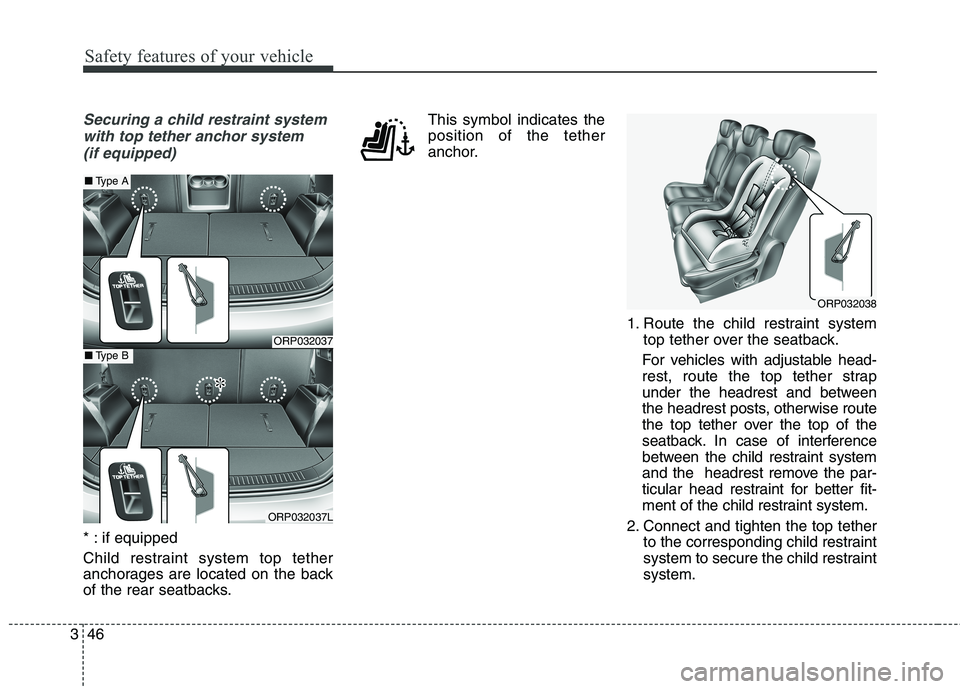
Safety features of your vehicle
46
3
Securing a child restraint system
with top tether anchor system (if equipped)
* : if equipped
Child restraint system top tether
anchorages are located on the back
of the rear seatbacks. This symbol indicates the position of the tether
anchor.
1. Route the child restraint systemtop tether over the seatback.
For vehicles with adjustable head-
rest, route the top tether strap
under the headrest and between
the headrest posts, otherwise route
the top tether over the top of the
seatback. In case of interference
between the child restraint system
and the headrest remove the par-
ticular head restraint for better fit-
ment of the child restraint system.
2. Connect and tighten the top tether to the corresponding child restraint
system to secure the child restraintsystem.
ORP032038
ORP032037
ORP032037L
■Type A
■Type B
Page 67 of 723
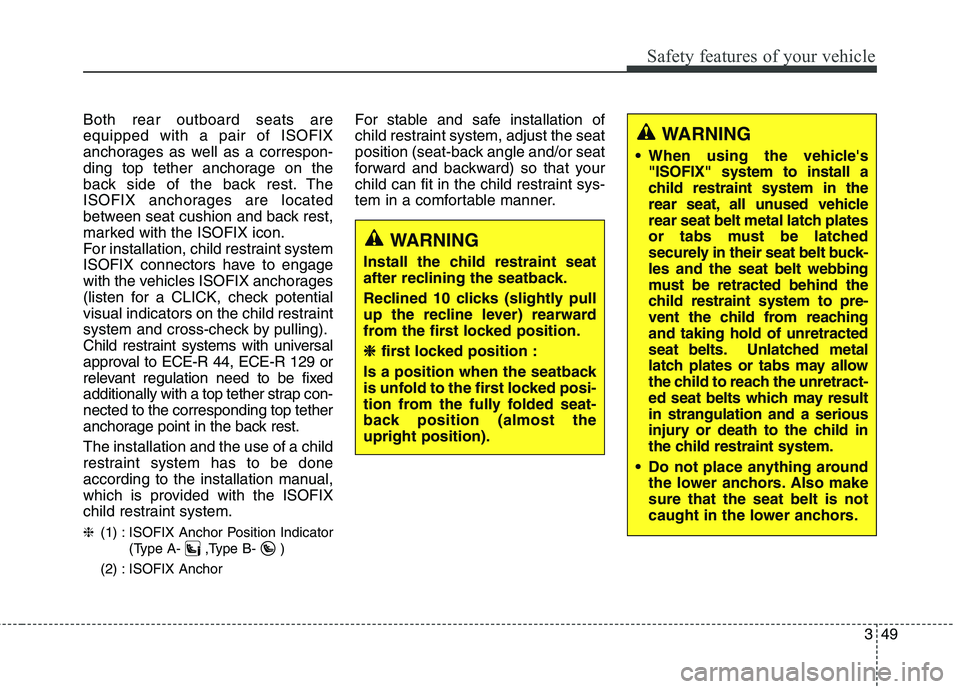
349
Safety features of your vehicle
Both rear outboard seats are equipped with a pair of ISOFIX
anchorages as well as a correspon-
ding top tether anchorage on the
back side of the back rest. The
ISOFIX anchorages are located
between seat cushion and back rest,
marked with the ISOFIX icon.
For installation, child restraint system
ISOFIX connectors have to engage
with the vehicles ISOFIX anchorages
(listen for a CLICK, check potential
visual indicators on the child restraint
system and cross-check by pulling).
Child restraint systems with universal
approval to ECE-R 44, ECE-R 129 or
relevant regulation need to be fixed
additionally with a top tether strap con-nected to the corresponding top tether
anchorage point in the back rest. The installation and the use of a child
restraint system has to be done
according to the installation manual,
which is provided with the ISOFIX
child restraint system. ❈(1) : ISOFIX Anchor Position Indicator
(Type A- ,Type B- )
(2) : ISOFIX Anchor For stable and safe installation of
child restraint system, adjust the seat
position (seat-back angle and/or seat
forward and backward) so that your
child can fit in the child restraint sys-
tem in a comfortable manner.
WARNING
Install the child restraint seat
after reclining the seatback.
Reclined 10 clicks (slightly pull
up the recline lever) rearward
from the first locked position. ❈
❈ first locked position :
Is a position when the seatback
is unfold to the first locked posi-
tion from the fully folded seat-
back position (almost theupright position).
WARNING
When using the vehicle's "ISOFIX" system to install a
child restraint system in the
rear seat, all unused vehicle
rear seat belt metal latch plates
or tabs must be latched
securely in their seat belt buck-les and the seat belt webbing
must be retracted behind the
child restraint system to pre-
vent the child from reachingand taking hold of unretracted
seat belts. Unlatched metal
latch plates or tabs may allow
the child to reach the unretract-
ed seat belts which may resultin strangulation and a serious
injury or death to the child in
the child restraint system.
Do not place anything around the lower anchors. Also makesure that the seat belt is not
caught in the lower anchors.
Page 68 of 723
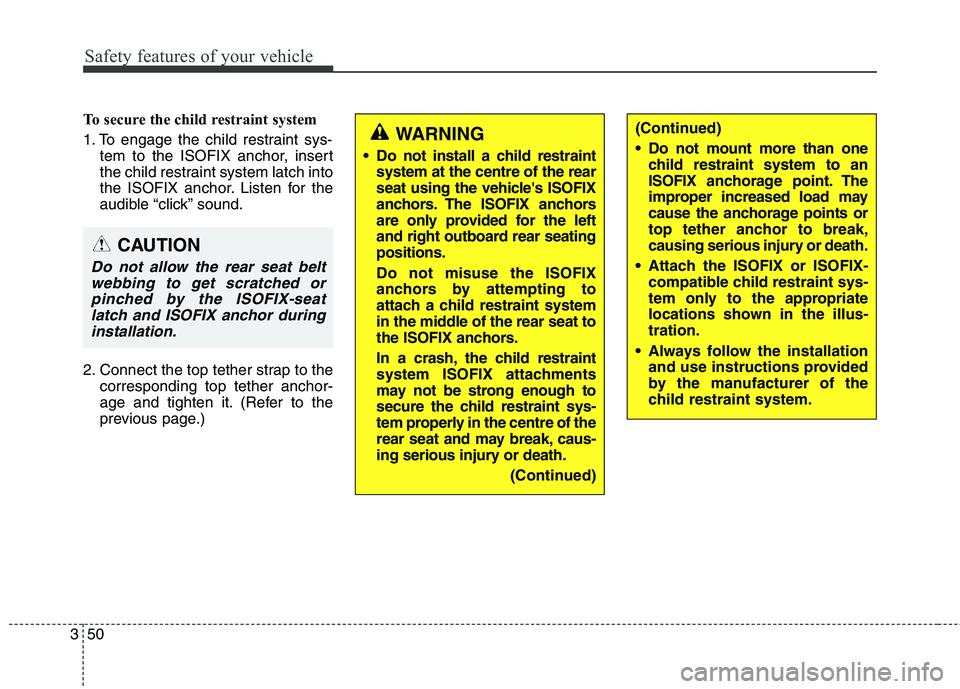
Safety features of your vehicle
50
3
To secure the child restraint system
1. To engage the child restraint sys-
tem to the ISOFIX anchor, insert
the child restraint system latch into
the ISOFIX anchor. Listen for the
audible “click” sound.
2. Connect the top tether strap to the corresponding top tether anchor-
age and tighten it. (Refer to the
previous page.)
CAUTION
Do not allow the rear seat belt
webbing to get scratched orpinched by the ISOFIX-seat latch and ISOFIX anchor duringinstallation.
WARNING
Do not install a child restraint system at the centre of the rear
seat using the vehicle's ISOFIX
anchors. The ISOFIX anchors
are only provided for the left
and right outboard rear seatingpositions. Do not misuse the ISOFIX
anchors by attempting to
attach a child restraint system
in the middle of the rear seat to
the ISOFIX anchors.
In a crash, the child restraint
system ISOFIX attachments
may not be strong enough to
secure the child restraint sys-
tem properly in the centre of the
rear seat and may break, caus-
ing serious injury or death.
(Continued)(Continued)
Do not mount more than onechild restraint system to an
ISOFIX anc horage point. The
improper increased load may
cause the anchorage points or
top tether anchor to break,
causing serious injury or death.
Attach the ISOFIX or ISOFIX- compatible child restraint sys-
tem only to the appropriate
locations shown in the illus-tration.
Always follow the installation and use instructions provided
by the manufacturer of the
child restraint system.